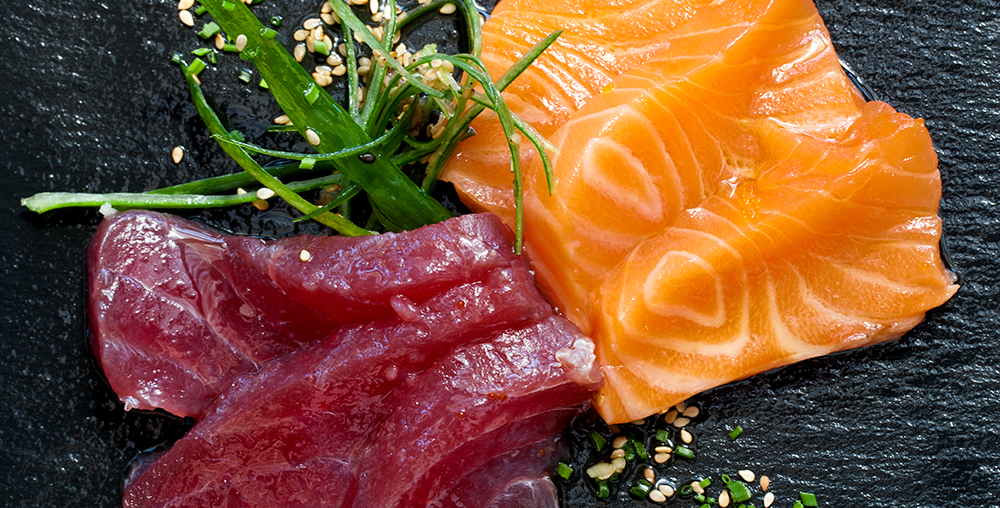Preparing fish
There are thousands of species of saltwater and freshwater fish. When cooking and eating them, freshness is key to ensuring their quality. Preparing a whole fresh fish requires knowledge of the type of fish and a certain amount of dexterity. It is even more important when it is to be eaten raw, as the Japanese do with their sushi and sashimi.
Fish prepared to be preserved
In the past, in order to supply areas located far from the coast, fish was first dried, smoked or put in brine to preserve its quality and enable it to be transported. Today’s methods of transportation and refrigeration mean fresh fish can be consumed in regions far from fishing areas.
Preparing a fresh fish requires knowledge and dexterity.
Before preparing a whole fish, it is important to ensure it is fresh. The gills should be moist and bright red, the eyes full, shiny and slightly bulging, and the skin glowing, pearly, taut and adhered to the flesh which should be firm and elastic. The scales should be shiny and still firmly attached, and the fish should have a pleasant smell.
Fish is prepared in four stages: scaling, trimming, gutting and, if necessary, filleting. Fish is generally scaled before it is gutted, as it is easier to scale if the belly is slightly rounded. The tools used are a fish scaler or the back of a knife. One hand holds the fish by the tail and the other removes the scales by moving the scaler at a 45 degree angle along the fish, working from the tail towards the head.
Trimming fish involves removing the fins. It is often necessary to wear gloves to do this in order to prevent injury, as the fins of some fish can be very sharp or secrete venom.
There are several methods for removing the guts. The easiest way is to extract them is by cutting the stomach open. It is also possible to make an incision of one or two centimetres near the gill.
Filleting is definitely the operation which requires the most dexterity. Round fish produce two fillets while flat fish produce four. These tasks are often performed by the fishmonger or carried out on board factory ships where fish is processed, packed and frozen. It is also possible to buy fillets, cross-section slices (steaks) or pieces of fresh or frozen fish. The best way to defrost fish is to place it in its original packaging in a refrigerator for between 18 and 24 hours.
Some specific methods of preparation
Carp, which is a pond fish, is first placed in fresh running water for a few days to remove the muddy taste.
The guts of some types of fish are of high nutritional quality. Cod liver oil, for example, is rich in essential fatty acids and in vitamins A and D. Other guts are poisonous, such as those of the fugu. The flesh of this fish is considered a great delicacy in Japan, but the guts contain a deadly toxin and must be removed extremely carefully.
Sashimi is a Japanese dish made from raw fish cut into thin slices. It showcases the chef’s expertise in choosing the freshest fish, cutting it and presenting it.
Rolled sushi, or maki sushi, is another Japanese speciality. It is made up of raw or cooked fish, molluscs or shellfish, and seasoned rice. The ingredients are rolled up in a sheet of dried seaweed. The final stage consists in slicing it into rolls. This requires a special knife whose blade is moistened with a blend of vinegar and water between each slicing.
Eating lightly with fish: a Christian custom!
An excellent source of protein and fat, fish holds a particular place in a Christian diet. During the Middle Ages in particular, fish was eaten on ‘lean days’ when meat was forbidden by the Church. It was not a dietary law whereby Christians were expected to eat lightly, but a form of partial fasting to help them be more disposed to prayer.
Poissons. 1997. L’encyclopédie des aliments. Paris : Éditions Fontaine
PAULI, Philip, 2008. Technologie culinaire. Winterthur : Pauli Fachbuchverlag AG
FLAVIGNY, Laure, 2000. Larousse gastronomique. Paris : Larousse-Bordas







